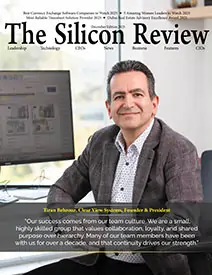>>
Industry>>
Environmental sustainability>>
How Manufacturing Is Adapting ...How Manufacturing Is Adapting to Meet Environmental Expectations
The Silicon Review
20 June, 2025
As environmental concerns grow worldwide, the manufacturing industry is under increasing pressure to adopt more sustainable practices. Long known for its significant environmental footprint, the sector is now evolving to meet rising expectations from governments, consumers, and investors. This shift toward sustainability is a strategic move to stay competitive and future-ready. By embracing innovation, cleaner energy, and smarter processes, manufacturers are proving that environmental responsibility and industrial growth can go hand in hand. In this blog post, we’ll explore the key ways manufacturing is adapting to align with today’s urgent environmental priorities and expectations.
![]()
Embracing Renewable Energy Sources
One of the most impactful changes in manufacturing has been the transition toward renewable energy. As factories historically relied heavily on fossil fuels, the pivot to solar, wind, and hydroelectric power marks a significant departure from past practices. Manufacturers are installing solar panels on-site, purchasing renewable energy credits, and even building their renewable power infrastructure. This shift reduces greenhouse gas emissions and helps stabilize energy costs, shielding companies from the volatility of fossil fuel markets. In some countries, governments offer tax incentives or subsidies for adopting renewable technologies, making the transition financially appealing. The long-term benefits include enhanced brand reputation, regulatory compliance, and a meaningful contribution to global emissions reduction goals.
Investing in Green Technology and Automation
Manufacturers are increasingly turning to green technology and automation to boost efficiency while reducing environmental impact. Innovations such as AI-powered systems, smart sensors, and IoT devices allow for real-time monitoring of energy use and emissions, enabling precise adjustments that cut waste and lower carbon footprints. Automated systems streamline production, minimizing errors and optimizing resource usage. These advancements play a critical role in sustainable manufacturing by enabling companies to produce more with fewer resources, ensuring long-term environmental and economic benefits. Technologies like 3D printing reduce material excess, while energy-efficient machinery helps meet regulatory requirements and improve overall operational sustainability.
Innovating with Sustainable Materials
A growing number of manufacturers are re-evaluating the raw materials they use, opting for sustainable alternatives that reduce environmental impact. This includes sourcing recycled materials, using biodegradable substances, or selecting suppliers who adhere to ethical and eco-friendly practices. For example, companies in the textile and automotive industries are experimenting with plant-based fabrics and recycled plastics. This reduces the demand for virgin materials and cuts down on landfill waste and pollution associated with extraction and processing. Manufacturers are investing in material innovation, developing proprietary blends that maintain product quality while minimizing ecological harm. Sustainable material sourcing is becoming a crucial differentiator in environmentally conscious markets.
Implementing Circular Economy Practices
Another transformative trend in manufacturing is the adoption of circular economy principles, which emphasize reuse, recycling, and remanufacturing. Instead of a traditional linear model, where products are made, used, and discarded, companies are designing goods with their end-of-life in mind. This could involve creating modular components that are easier to disassemble and recycle or setting up take-back programs where consumers return used products for refurbishment. Electronics and appliance manufacturers are leading this charge by offering extended product lifecycles and encouraging component reuse. These practices significantly reduce waste, lower production costs, and foster customer loyalty by promoting environmental responsibility. The circular economy model represents a fundamental rethinking of product design and supply chains.
Improving Waste Management Systems
Effective waste management is a critical component of environmentally responsible manufacturing. Companies are adopting new practices to reduce, reuse, and recycle waste generated during production. This includes better sorting systems, investment in waste-to-energy technology, and partnerships with third-party recyclers. Hazardous waste is now handled with stricter protocols to prevent environmental contamination. Manufacturers are striving to reduce water waste through closed-loop systems that recycle water within production lines. In industries such as food and beverage, byproducts are repurposed into animal feed or compost, significantly cutting down on landfill contributions. These efforts help the environment and reduce disposal costs and potential fines from regulatory agencies.
Complying with Environmental Regulations and Standards
![]()
The rise in environmental awareness has led to stricter regulations, compelling manufacturers to adhere to international and local environmental standards. From emissions caps to waste disposal laws, compliance is no longer optional. Companies are now proactively implementing environmental management systems such as ISO 14001, which provide frameworks for reducing environmental impact. Staying ahead of regulations offers a competitive advantage, as non-compliance can result in fines, sanctions, and reputational damage. Environmental audits, sustainability reporting, and third-party certifications have become common practices, helping manufacturers showcase their commitment to transparency and responsibility.
The manufacturing sector is rising to the challenge of meeting environmental expectations through a multifaceted approach that includes adopting renewable energy, innovating materials, embracing circular economy models, investing in green technologies, improving waste management, and complying with evolving regulations. These efforts are about securing a future where industrial growth and environmental stewardship go hand in hand. As global challenges intensify, the manufacturers who lead the charge toward sustainability will be those who survive and thrive in a changing world.
_2025-12-15_12-44-58.webp)


_2025-11-17_06-38-14.webp)

 (1)_2025-10-21_13-35-14.webp)
